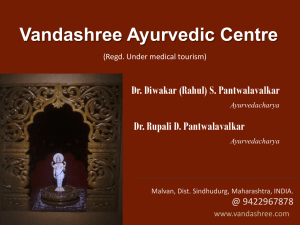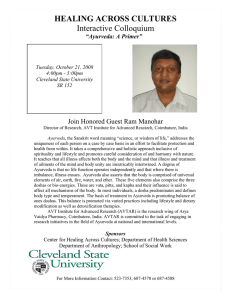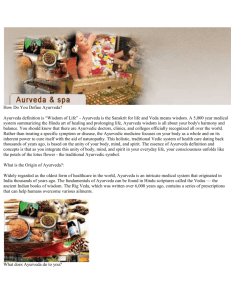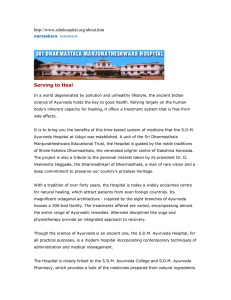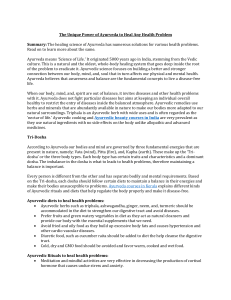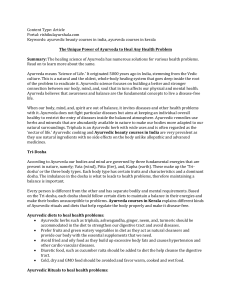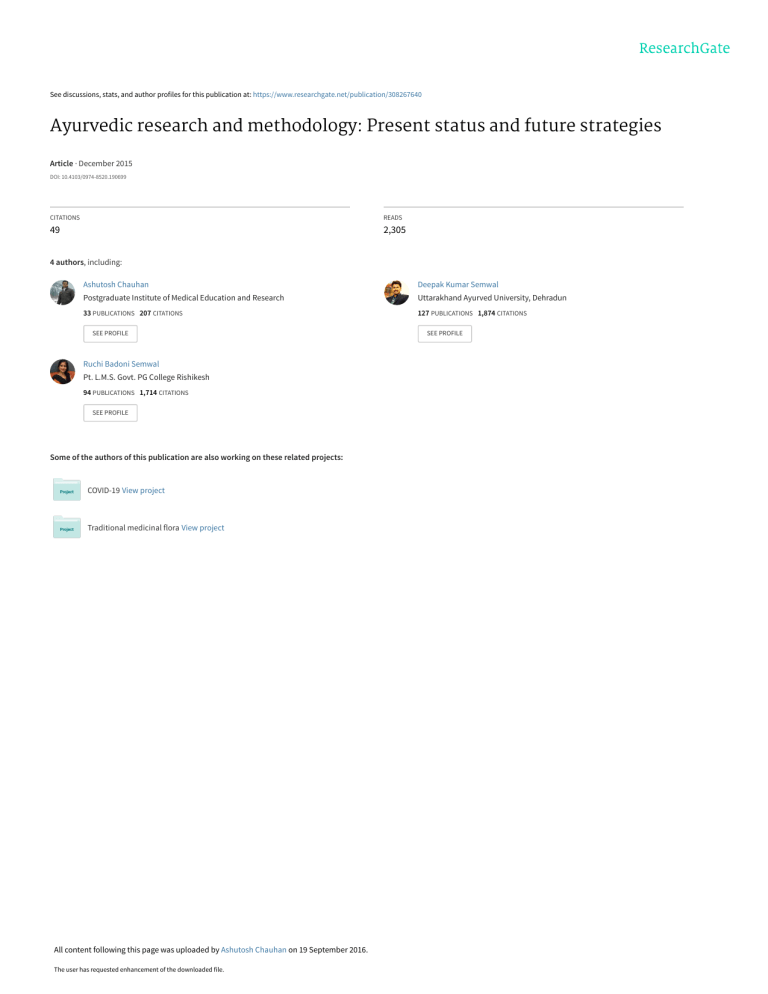
See discussions, stats, and author profiles for this publication at: https://www.researchgate.net/publication/308267640
Ayurvedic research and methodology: Present status and future strategies
Article · December 2015
DOI: 10.4103/0974-8520.190699
CITATIONS
READS
49
2,305
4 authors, including:
Ashutosh Chauhan
Deepak Kumar Semwal
Postgraduate Institute of Medical Education and Research
Uttarakhand Ayurved University, Dehradun
33 PUBLICATIONS 207 CITATIONS
127 PUBLICATIONS 1,874 CITATIONS
SEE PROFILE
Ruchi Badoni Semwal
Pt. L.M.S. Govt. PG College Rishikesh
94 PUBLICATIONS 1,714 CITATIONS
SEE PROFILE
Some of the authors of this publication are also working on these related projects:
COVID-19 View project
Traditional medicinal flora View project
All content following this page was uploaded by Ashutosh Chauhan on 19 September 2016.
The user has requested enhancement of the downloaded file.
SEE PROFILE
[Downloaded free from http://www.ayujournal.org on Monday, September 19, 2016, IP: 116.202.36.127]
AYU
Access this article online
Website: www.ayujournal.org
DOI: 10.4103/0974-8520.190699
Review Article
Quick Response Code:
Ayurvedic research and methodology: Present status and
future strategies
Ashutosh Chauhan, Deepak Kumar Semwal1, Satyendra Prasad Mishra2, Ruchi Badoni Semwal3
Departments of Biotechnology and 1Phytochemistry, Faculty of Biomedical Sciences, 2Vice Chancellor,
Uttarakhand Ayurved University, Dehradun, Uttarakhand, India, 3Department of Pharmaceutical Sciences,
Tshwane University of Technology, Pretoria, South Africa
Abstract
Ayurveda is a science of life with a holistic approach to health and personalized medicine. It is one
of the oldest medical systems, which comprises thousands of medical concepts and hypothesis.
Interestingly, Ayurveda has ability to treat many chronic diseases such as cancer, diabetes, arthritis,
and asthma, which are untreatable in modern medicine. Unfortunately, due to lack of scientific
validation in various concepts, this precious gift from our ancestors is trailing. Hence, evidence‑based
research is highly needed for global recognition and acceptance of Ayurveda, which needs further
advancements in the research methodology. The present review highlights various fields of research
including literary, fundamental, drug, pharmaceutical, and clinical research in Ayurveda. The review
further focuses to improve the research methodology for Ayurveda with main emphasis on the
fundamental research. This attempt will certainly encourage young researchers to work on various
areas of research for the development and promotion of Ayurveda.
Key words: Ayurvedic research and methodology, personalized medicine, Rasayana, traditional
medicine
Introduction
high cost of new drugs, microbial resistance, and emerging
diseases, etc.[4]
Ayurveda, the traditional Indian medicinal system remains the
most ancient yet living traditions with sound philosophical
and experimental basis. It is a science of life with a holistic
approach to health and personalized medicine. It is known
to be a complete medical system that comprised physical,
psychological, philosophical, ethical, and spiritual health.[1] In
Ayurveda, each cell is considered to be inherently an essential
expression of pure intelligence hence called self‑healing
science.[2] In addition, to the self‑healing concept, the use of
herbal treatment is equally important in this Indian traditional
system of medicine.
Ayurvedic treatment is although highly effective; proper
mode of action, pharmacology, pharmacokinetics, and
pharmacovigilance of many important Ayurvedic drugs are still
not fully explored. Moreover, the comprehensive knowledge
of the basic ideologies of Ayurveda is poorly acceptable
scientifically due to lack of evidence. In the modern time,
when the Western medicinal system is reached almost at the
top because of validated research and advanced techniques,
there is an urgent need to validate basic principles as well as
drugs used in the ayurvedic system of medicine with the help
of advanced research methodology. Therefore, advancements in
the ongoing research methodology are highly required for the
promotion of Ayurveda.
According to the World Health Organization, about 70–80%
of the world populations rely on nonconventional medicines
mainly of herbal sources in their healthcare.[3] Public interest
for the treatment with complementary and alternative
medicine is mainly due to increased side effects in synthetic
drugs, lack of curative treatment for several chronic diseases,
Address for correspondence: Dr. Deepak Kumar Semwal,
Department of Phytochemistry, Faculty of Biomedical
Sciences, Uttarakhand Ayurved University,
Dehradun ‑ 248 001, Uttarakhand, India.
E‑mail: dr_dks. 1983@yahoo.co.in
364
This is an open access article distributed under the terms of the Creative
Commons Attribution‑NonCommercial‑ShareAlike 3.0 License, which allows
others to remix, tweak, and build upon the work non‑commercially, as long as the
author is credited and the new creations are licensed under the identical terms.
For reprints contact: reprints@medknow.com
How to cite this article: Chauhan A, Semwal DK, Mishra SP, Semwal RB.
Ayurvedic research and methodology: Present status and future strategies.
Ayu 2015;36:364-9.
© 2015 AYU (An International Quarterly Journal of Research in Ayurveda) |
Official publication of Institute For Post Graduate Teaching & Research in Ayurveda,Jamnagar | Published by Wolters Kluwer - Medknow
[Downloaded free from http://www.ayujournal.org on Monday, September 19, 2016, IP: 116.202.36.127]
Chauhan, et al.: Research methodology for Ayurveda
Why Ayurvedic System of Medicine
Lagging Behind?
Undoubtedly, in comparison to allopathic treatment, Ayurvedic
treatment is more effective in most of the chronic diseases.
However, the popularity of Ayurveda is rather lesser as the
majority of the global population prefers modern medicine
because of its ability to give fast relief from diseases as
compared to Ayurvedic treatment. Recently, the awareness and
thus fear of toxicity to allopathic drugs and the high cost of
healthcare are causing an increasingly large number of people
to seek alternatives. Rather than competing and veering
towards the Western medicine, the Ayurvedic scientists should
work to enhance the core competency of Ayurveda without
compromising its fundamental principles.[5] Some major points
which are responsible for trailing the Ayurveda are as following.
•
Young Ayurvedic scholars, although enthusiastic, are
not clear about their views on the future of Ayurveda.
Moreover, they are not even very clear that how to expose
their valuable research outputs on Ayurveda
•
Only a few organizations have well‑established research
infrastructure for exclusive research in Ayurveda.
Experienced researchers with knowledge of modern
technologies are required to conduct advance and quality
research in Ayurveda
•
There is a lack of cooperation and willingness of
Biomedical Scientists who are often unduly skeptical and
carry prejudice
•
More than a thousand Ayurvedic postgraduates pass out
each year and enter into the streamline of academics and
practice. Among them, only a few choose their profession
as researcher in Ayurveda
•
Neither has the Ayurvedic teaching changed in the
last 50 years nor have the textbooks enriched with new
research methodologies.
These are some of the following major points those should
be highly needed to consider in the Ayurvedic research for its
advancement.
Improvement in research methodology
Research methodology is a way to systematic collection,
analysis, and interpretation of data to solve a research problem.
India does not need to prove the validity of Ayurveda to its
people, authorities, and own scientific community because it is
a recognized traditional medical system of the country. There
is a need of fundamental research on Ayurveda to refresh and
upgrade the tremendous knowledge diluted through time
particularly during the British rule. This kind of research will
certainly upgrade the fundamental knowledge of Ayurveda,
which will be benefitted not only to Indian but also to foreign
nationals. This will assure Ayurveda to be practiced with its
whole potential and allowed to gain wide recognition. Research
is a process that converts data into information, information
into knowledge, and knowledge into wisdom. In the present
scenario, Ayurvedic researches are failing in this aspect as these
are unable to disseminate the knowledge gained from the
exercises.[6]
The glorious past of the research methodology of Ayurveda
is based on the tools of examination known as Pareeksha
AYU | Oct-Dec 2015 | Vol 36 | Issue 4
and inspired from the philosophical term Pramaana, which
refers to the evidence.[7] These tools of the examination
include (i) the direct observation (Pratyaksha), (ii) the
inference (Anumana), and (iii) the authoritative testimonies
or literature (Aptopadesha). The modern day research also
depends on these three basic tools whose efficacy has been
augmented by the utility of the scientific and technological
innovative devices. These methods of investigations have been
planned to develop the backbone of the Ayurveda system in
the form basic principles under the fundamental research. The
quality researches on Ayurveda basics with advanced scientific
techniques can expand the knowledge and path of current
medical science. Predominantly, drug researches done in the
field of Ayurveda in the last six decades have not enriched
the Ayurvedic understandings or Ayurvedic concepts. However,
these researches have created a better understanding of
Ayurveda by the modern medical fraternity.
Now, it is the time to define Ayurveda itself that whether
the use of herbs is Ayurveda or the use of herbs and other
treatment modalities as per Ayurvedic principles is Ayurveda.
The research methodology should be planned and adopted
accordingly. At the time of deciding research methodology in
Ayurveda following things should be kept in mind.[8]
•
Basic differences between Ayurveda and modern science
should be taken into account when designing the research
protocols
•
The main concern must be given to the classical approach
of Ayurveda
•
Research protocols should be designed on the basic
concepts of Ayurveda, i.e., Prakriti, Agni, Dhatu, Srotas,
Rasayana, Shatkriyakala, Agnibala, Ojabala, Manobala,
etc.
•
The research work should involve experts both from
Ayurveda and biomedical specialties
•
The holistic and integrative approach involving body,
mind, and spirit should be considered for research
•
Before starting the clinical studies; a complete knowledge
about diagnosis of the disease, materials to be used,
process to be adopted, and accurate dosage form is highly
needed
•
The approach of personalized medicine should be followed
during treatment.
Research methodology in the advancement of Ayurveda varies
with each assignment or project. The major areas of research can
be divided into five major areas, namely, literary, fundamental,
drug, pharmaceutical, and clinical research. Although there is
no single way to conduct research, certain methods and skills
can make research efforts more efficient and effective.
Encouragement of research on Ayurvedic
fundamentals
Fundamental research needs to be done in the fields of
Ayurvedic physiology, pathology, pharmacology (fundamental
and clinical), and pharmaceuticals. The basic concept of
Srotovijnana (knowledge of channels) as a main matrix of
Ayurvedic biology has been highlighted both by fundamental
and applied knowledge.[9] A living body is a system which
comprised innumerable channels designed as an inner
transport system for a variety of functions. The health and
disease depend on the system of Srotas, which is prone to
365
[Downloaded free from http://www.ayujournal.org on Monday, September 19, 2016, IP: 116.202.36.127]
Chauhan, et al.: Research methodology for Ayurveda
lose its function by various factors including erroneous food
and lifestyle. Ayurveda developed a therapeutic technology for
Samshodhana (biopurification) familiarly known as Panchakarma
therapy. Ayurveda can be better understood through philosophy
and physics rather than modern biology because the study
of the full spectrum of the Srotas can help to define the
phenomenon of relationships in structural and functional
biology.[10] Moreover, the fundamental concept of Ayurveda for
a perfect health including restoration and maintenance can also
be understood through quantum theory.[11,12]
The fundamental research in Ayurveda caters demands of
the society and the medical fraternity; the modern scientific
research has been initiated in Ayurveda in the field of basic
principles. The aim of basic research in Ayurveda is to explore
the scientific innovations and opportunities in fundamental
concepts of Ayurveda. The fundamental research includes
replacement of faith and suppositions with the scientific
reasoning complimented with the facts and figures. The
objectives of the investigation in the fundamental research
are categorized into the human body (Purusha), the disease
(Vyadhi), the medicine (Aushadha), and the right time for
action (Kriyakala).[13]
Validation of Ayurvedic drugs with reverse
pharmacology
The reverse pharmacology refers to reversing the routine clinic
practice to the laboratory examination for the proper validation
of a traditional medicinal system.[14] It is an interesting and
important scientific approach to develop new drug candidates or
formulations from already known facts in traditional medicines
through sound preclinical and clinical researches.[15]
Previous researches, particularly for the past few decades,
validated a few concepts of herbal drugs by reverse
pharmacology, which is obviously tremendous work for
Ayurveda. These researches also supported the use of crude
drugs rather than plant isolates or purified fractions for clinical
trials due to the combined effects of phytoconstituents. Such
researches generated a lot of interest in researchers towards
herbal medicines and consequently, in the last decade a demand
of Ayurveda and other traditional medicines has increased in
the medical world.
In addition, the reverse pharmacology approach can help in
reducing failure rates of clinical implication of the herbs or
their formulations which are already described in Ayurveda.
This approach gives an opportunity to seek new synergistic
combinations and improvements in bioavailability and
innovative strategies that can play a significant role in drug
development. Various previous studies on piperine revealed that
its combination improves the bioavailability of synthetic drugs
such as propranolol, theophylline, and rifampicin.[16]
Day by day, drug industry is facing serious challenges, as the
drug discovery process has become extremely expensive, riskier,
and critically inefficient. Postmarketing failures of blockbuster
drugs and a serious innovation deficit are the major concerns
of big pharma companies. Consequently, there has been a
remarkable shift in favor of single to multitargeted drugs,
especially for polygenic syndrome based on the traditional
medicinal knowledge.
366
Evidence‑based benefits of traditional approaches
There are many evidences, which supported Ayurveda
performances better than Western medicine, mainly in case
of chronic diseases, but it needs to validate with advanced
scientific procedures. Ayurveda recommends the use of copper
pot for water‑purification as copper pot has antibacterial
effect against important diarrheagenic bacteria including
Vibrio cholerae, Shigella flexneri, enterotoxigenic Escherichia
coli, enteropathogenic E. coli, Salmonella enterica typhi and
Salmonella paratyphi, which is scientifically validated.[1,17]
Ayurveda also has the ability of wound healing via a topical
route with the help of various preparations.[18] Moreover, many
Ayurvedic formulations and Rasayanas have scientifically
validated in various in vivo models. In this connection,
Amalaki, an Ayurvedic Rasayana, and Rasa Sindoora, an
organometallic derivative of mercury are effective in longevity,
development, fecundity, stress tolerance, and heterogeneous
nuclear ribonucleoprotein levels of Drosophila melanogaster.[19]
On the other hand, Bhasma, an ash obtained through
incineration of plants and animal derivatives (horns, shells,
feathers, etc.), metallic, and nonmetallic minerals, etc., is
another example of traditional approach in which the starting
material undergoes an elaborate process of purification
(Shodhana), followed by the reaction phase, which involves
the incorporation of some other mineral and herbal extracts.[20]
Bhasma preparation is similar to the present‑day nanotechnology
having nano‑size (25–50 nm) particles. Although Bhasmas
are complex materials, physicochemical analysis using modern
techniques can be most attractive for the standardization of
Bhasma medicines. This can be certainly helpful in building
confidence in the use of such products for medication by
ensuring safety, efficacy, and batch to batch uniformity.[21]
Encouragement of interdisciplinary research
There is a need of involving all basic sciences such as
Physics, Chemistry, Molecular Biology, and Biotechnology
together with Ethnopharmacology, Ayurvedic Drug Discovery,
Pharmacoepidemiology, Reverse Pharmacology and various other
areas for the better understanding, and optimistic outcome of
Ayurveda research. In the past few years, the interdisciplinary
concept of research is also introduced in Ayurveda mainly for
integrative medicine.[8]
In Western countries, the multidimensional approach by
combining traditional and modern medicine is growing day
by day. The clinical efficacy of many traditional medications
for a variety of diseases has been found comparatively better
than that of modern medicine.[22] The Ayurvedic system of
medicine is very safe that can help in reducing the enormous
burden of mortality and morbidity caused by the various side
effects of conventional prescribed drugs. This traditional system
is also found effective against various diseases where pathogens
developed antibiotic resistance. Thus, interdisciplinary
researches are highly needed to fight against most chronic
diseases.
Improvement in quality of herbal drugs
Most of the Ayurvedic Rasayanas (Medhya, Jeevaniya, and
Lekhaniaya, etc.) are based on the herbal products. Many herbs
such as Ashwagandha (Withania somnifera Dunal.), Shatavari
(Asparagus racemosus Willd.), Guduchi (Tinospora cordifolia
AYU | Oct-Dec 2015 | Vol 36 | Issue 4
[Downloaded free from http://www.ayujournal.org on Monday, September 19, 2016, IP: 116.202.36.127]
Chauhan, et al.: Research methodology for Ayurveda
(Thunb.) Miers), Amalaki (Embellica officinalis Gaertn.), and
Bhallataka (Semecarpus anacardium Linn.) are well‑known
Ayurvedic Rasayanas, which are proven immunomodulators.
Adjuvants are required for many of weak immunogenic vaccines,
and Ayurvedic rasayanas may offer better and safer immune
drugs that can be used as adjuvants in such vaccines and also in
cancer treatment.[23]
to fulfill the supply and meet market demand. There is a
need to ensure correct raw materials for the medicine and for
this purpose, it is important to carefully monitor entire cycle
of raw material collection such as harvesting, processing,
transportation, and storage before their use. Moreover, selection
of the correct germplasm using modern DNA fingerprinting and
chemoprofiling techniques be used taken on priority basis.[31]
Herbal extracts of therapeutic relevance are of great importance
as reservoirs of structural and chemical diversity. Interestingly,
more than 120 distinct phytochemicals from different plants
have capability as lifesaving medicines. These compounds
have been achieved through chemical and pharmacological
screening of only 6% of the total plant species.[24] The National
Institute of Health has already started extensive research for
anti‑inflammatory compounds from turmeric, ginger, and
Boswellia with the aid of Ayurvedic knowledge. The screening
of numerous herbs for treating cancer has been done using
traditional knowledge on such herbs.[25] Moreover, a variety of
drugs of immunomodulating capacity from traditional medicine
can provide newer opportunities to improve therapeutic
spectrum.[26]
Upgradation of Ayurveda literature
In case of herbal drugs, consistency in the chemical
composition and bioactivity are essential requirements for
their safe and effective use because the quality is the primary
need for safety and efficacy of plant‑derived medicines. In case
of Ayurvedic preparations, most of the drugs are polyherbal
formulations, and proper quality control is still a serious issue.
Consequently, till the date, the acceptability of Ayurvedic drugs
in the international market is very poor. There must be some
procedures and techniques to analyze these drugs (extracts or
formulations) for their composition and strength.[27] Thus, there
is a need to insure the standard quality of Ayurvedic products.
Active involvement of government
The government should be prepared a timeframe roadmap
for the progressive development of Ayurvedic education
and research. Science‑based approaches may be promoted,
utilized, and inculcated in the education of Ayurveda like
traditional Chinese medicine (TCM). It is most appreciable
that China has about 95% of Department of Traditional
Medicine in their government hospitals. That is why their
traditional medicinal system got global recognition and
acceptable everywhere.[28] Recently, Youyou Tu, has won Nobel
Prize in Medicine for discovering Artemisinin, a drug that has
significantly lowered mortality rates from malaria, based on a
TCM remedy.[29] India has to develop similar type of policies in
the healthcare system for the development of Ayurveda.
Development of Ayurvedic pharma sector
The drug manufacturing industries and other supporting
industries play important role in the development of Ayurvedic
medicine. The whole supporting system, i.e., raw material
collectors, dealers, processing and manufacturing industries,
Ayurveda practitioners, and consumers must be encouraged.
Around 1100 medicinal plants are used as medicine and
among them at least 60 plants are of great demand.[30] Today,
as the demand for herbal products is increasing day by day,
enough availability of raw materials with reasonable prices
is a big challenge for the industries. Hence, some strict steps
must be taken by the government as well as industries itself
AYU | Oct-Dec 2015 | Vol 36 | Issue 4
Ayurveda is continuously facing constraints and difficulties
from regulatory authorities and the scientific community,
which is coming in the way of its global acceptance.[32] The
available literature on the use of Ayurveda for the treatment
of diseases is still not evidence based. There is a need of more
evidence‑based researches in this area to make the literature
adequate. In this connection, Digital Helpline for Ayurveda
Research Articles provides a first of its kind resource to access
research articles on Ayurveda must be improved and updated.
More than thousands of articles indexed in renowned PubMed
every year, unfortunately, out of them a very few belong to
Ayurveda research. However, the articles based on TCM cover
around 12% of total published papers.[33] Therefore, Ayurvedic
literature has to make its huge contribution in PubMed for the
international recognition.
Revalidation of clinical trials
The clinical trials on Ayurvedic medicines must be revalidated
to find out better treatment modalities by improving scientific
procedures, dose forms, and side effects of any given drug. The
development of a method to allow placebo controls for changing
and individualizing therapies is an important step in providing
the basis for a meaningful comparison of not only classic
Ayurveda but also other traditional medicinal systems with
allopathic treatment in ways acceptable to Western standards.
This approach also shows that double‑blind, placebo controlled,
randomized studies are possible when testing classic Ayurvedic
versus allopathic medications. Larger trials are needed and are
clearly possible.[34] The Ayurvedic clinical trials must follow
consolidated standards of reporting trails statement for global
recognition.
Combination of Ayurveda and Western medicine
No doubt, Indian system of medicine has already received much
attention in academic fields. The popularity of Ayurveda is
mainly due to its therapeutic efficiency against most chronic
diseases where modern medicines are ineffective.[35] The
Western medicine, on the other hand, introduced in Asian
countries in early 16th century, when travelers from Western
countries began to settle and found themselves in greater
contact with native people.[36] This medicinal system got high
popularity within a very short period due to its fast action over
traditional medicinal systems.
Interestingly, there are certain examples of Ayurveda and
Western medicine work well when used in combination. For
example, rheumatoid arthritis, a chronic and immune‑mediated
disease that causes pain and inflammation are not well treatable
in modern Western medicine. Present, methotrexate achieves
a response in 40–60% patients which cannot say satisfactory at
all. Furthermore, methotrexate is associated with distressing and
potentially serious side effects. As a result, 68–94% of arthritis
patients use complementary and alternative medicine therapy
367
[Downloaded free from http://www.ayujournal.org on Monday, September 19, 2016, IP: 116.202.36.127]
Chauhan, et al.: Research methodology for Ayurveda
including Ayurveda.[34] Therefore, Ayurveda and Western
medicine should be considered as two sides of a coin, and they
must come together to work for humankind.
Resolution of controversies in Ayurvedic drug
It is not always the case that Ayurvedic medicines do not show
adverse effects. In a random sample of commercially prepared
Ayurvedic drugs purchased online via internet, it has found
that nearly 21% contained detectable levels of lead, mercury,
and arsenic. The Rasa shastra medicines were more than twice
as likely as non‑Rasa shastra medicines to contain detectable
levels of such metals which are said to be highly toxic for the
body.[37] Such reports are to be addressed appropriately, so
that the concerns can be answered in time preventing further
damage to the heritage. These Ayurvedic formulations must
have to critically standardized before their marketing.
Improvement in personalized medicine with
modern technology
The concept of Ayurveda treatment is broad, which heal the
human being as a whole whereas Western system of medicine
has traditionally operated from only a cure model. Now, the
time has come to create a new model of the medicinal system
by combining both healing and cure models. The value of health
care could be increased tremendously through personalized
medicine that could be helpful to predict disease risk, prevent
progress of disease, and manage treatments more efficiently.
Moreover, the developments in the area of pharmacogenetics
and pharmacogenomics can help the practitioner to achieve
the target of personalized medicine.[38] A personalized medicine
does not mean just the right drug for the right individual
but the right drug for the specific disease affecting a specific
individual.[39] This concept will surely make clinical trials more
efficient by reducing the cost usually raises due to side effects,
and prescription of drugs those are not effective in certain
genotypes.[40]
The concept of personalized medicine is very old and used
as long as people have been practicing medicine.[7] In recent
time, the personalized medicine is all about DNA while single
nucleotide polymorphism and epigenetic factors influence drug
response and form the basis of personalized medicine.[41] Hence,
the personalized medicine must be improved with the help
of modern scientific techniques to promote Indian system of
medicine.
Conclusion
Today, the cost of health care is constantly rising, and affecting
people’s ability to afford health coverage. Drug‑based medicines
are being unaffordable for economically poor countries like India
and problematic in the Western countries due to numerous
side effects. The drug should be the last rather than first mean
of treatment, beginning with the natural healing method like
Ayurveda. One of the Ayurvedic treatment modalities such
as Panchkarma can remove disease before its manifestation.
Having all the above beauties, Ayurveda is still lagging behind
because of the lack of scientific evidence in many cases and
poor research methodology.
368
The development of guidelines for methodology in Ayurveda
requires a huge professional work both by academicians and
practitioners who must have the necessary knowledge and
motivation for this task. Otherwise, Ayurveda will gradually lose
its identity and will become a history of medicine. Although
the process of research is time taking but it is the only way
to overcome the difficulties in the promotion of Ayurveda
worldwide. The work in a coordinated and well‑organized
manner with no bias can improve Ayurveda. Nevertheless, it
also a bitter truth that modern researches have not been very
rewarding for Ayurveda itself as most of these researches is being
used Ayurveda to extend modern bioscience. Hence, there is an
urgent need to design advanced research methodology for the
validation of Ayurvedic fundamentals as well as its treatments.
There is a huge difference in the approach of allopathic and
Ayurvedic medicines. Ayurveda has evolved as a holistic system
having an understanding of physiology enabling it to maintain
and restore health with a few side effects and will focus rather
on health, while allopathy whose analytic understanding of
physiology leads mainly to suppression of symptoms with many
side effects. Similarly, there is a great contribution of allopathy
in the fields of emergency medicine, diagnostic techniques,
and surgery where the existing practice of Ayurveda cannot
compete. Thus, both systems have to complement each other
in the benefit of ailing. Ayurveda requires more researches in
the areas of fundamental principles and diagnostic tools in
place of drug research. In the present scenario, the research
methodology of Ayurveda is not good enough, which needs
further advancements in the development and promotion of
Ayurveda.
Acknowledgment
Authors are thankful to UAU, Dehradun for providing access to
all relevant literature on research methodology of Ayurveda.
Financial support and sponsorship
Nil
Conflicts of interest
There are no conflicts of interest.
References
1.
2.
3.
4.
5.
6.
7.
8.
9.
Semwal DK, Mishra SP, Chauhan A, Semwal RB. Adverse health
effects of tobacco and role of Ayurveda in their reduction. J Med Sci
2015;15:139‑46.
Lad V. Ayurveda, the Science of Self‑Healing: A Practical Guide. 2nd ed.
New Delhi: Lotus Press; 1987.
Jacqui W. Herbal products are often contaminated, study finds. BMJ
2013;347:f6138.
Humber JM. The role of complementary and alternative medicine:
Accommodating pluralism. J Am Med Assoc 2002;288:1655‑6.
Basisht G. Exploring progression of Ayurveda. Ayu 2011;32:445‑7.
Baghel MS. Need of new research methodology for Ayurveda. Ayu
2011;32:3‑4.
Sharma PV, editor. Charaka Samhita of Agnivesha, Sutra Sthana, Ch. 11,
Ver. 2. Varanasi: Choukhamba Orientalia; 1995. p. 114.
Patwardhan B. The quest for evidence‑based Ayurveda: Lessons learned.
Curr Sci 2012;102:1406‑17.
Morandi A, Tosto C, Sartori G, Roberti di Sarsina P. Advent of a link
between Ayurveda and modern health science: The proceedings of the
first international congress on ayurveda, “Ayurveda: The Meaning of
AYU | Oct-Dec 2015 | Vol 36 | Issue 4
[Downloaded free from http://www.ayujournal.org on Monday, September 19, 2016, IP: 116.202.36.127]
Chauhan, et al.: Research methodology for Ayurveda
10.
11.
12.
13.
14.
15.
16.
17.
18.
19.
20.
21.
22.
23.
24.
25.
26.
Life‑Awareness, Environment, and Health” March 21‑22, 2009, Milan, Italy.
Evid Based Complement Alternat Med 2011;2011:929083.
Singh RH. Integrative Medicine, Special Monograph. New Delhi:
Choukhamba Surbharti; 2009.
Hankey A. The scientific value of Ayurveda. J Altern Complement Med
2005;11:221‑5.
Jayasundar R. Ayurveda: A distinctive approach to health and disease.
Curr Sci 2010;98:908‑14.
Sharma PV, editor. Sushruta Samhita, Sutra Sthana, Vol. 1, Ch. 1, Ver. 22.
Varanasi: Choukhamba Visvabharati; 2013. p. 16.
Patwardhan B, Vaidya AD. Natural products drug discovery: Accelerating
the clinical candidate development using reverse pharmacology
approaches. Indian J Exp Biol 2010;48:220‑7.
Vaidya AD. Reverse pharmacological correlates of Ayurvedic drug actions.
Indian J Pharmacol 2006;38:311‑5.
Kola I, Landis J. Can the pharmaceutical industry reduce attrition rates?
Nat Rev Drug Discov 2004;3:711‑5.
Sudha VB, Ganesan S, Pazhani GP, Ramamurthy T, Nair GB,
Venkatasubramanian P. Storing drinking‑water in copper pots kills
contaminating diarrhoeagenic bacteria. J Health Popul Nutr 2012;30:17‑21.
Datta HS, Mitra SK, Patwardhan B. Wound healing activity of topical
application forms based on Ayurveda. Evid Based Complement Alternat
Med 2011;2011:134378.
Dwivedi V, Anandan EM, Mony RS, Muraleedharan TS, Valiathan MS,
Mutsuddi M, et al. In vivo effects of traditional Ayurvedic formulations in
Drosophila melanogaster model relate with therapeutic applications. PLoS
One 2012;7:e37113.
Bhowmick TK, Suresh AK, Kane SG, Joshi AC, Bellare JR. Physicochemical
characterization of an Indian traditional medicine, Jasada Bhasma:
Detection of nanoparticles containing non‑stoichiometric zinc oxide.
J Nanopart Res 2009;11:655‑64.
Pal D, Sahu CK, Haldar A. Bhasma: The ancient Indian nanomedicine.
J Adv Pharm Technol Res 2014;5:4‑12.
Morandi A, Sartori G, Tosto C. Ayurveda‑LaMedicina tradizionale Indiana.
In: Giarrelli G, di Sarsina PR, Bilvestrini B, editors. Le Medicine Non
Convenzionali in Italia – Storia, Problemi e Prospettive di Integrazione.
Milan (Italy): Franco Angeli; 2007. p. 291‑309.
Mishra SP, Semwal DK, Chauhan A. Scenario of Ayurveda education
in India: Some recommendations for development. University
News – Association of Indian Universities 2015;53:3‑8.
Goswami A, Barooch PK, Sandhu JS. Prospect of herbal drugs in the age
of globalization – Indian scenario. J Sci Ind Res 2002;61:423‑43.
Diwanay S, Gautam M, Patwardhan B. Cytoprotection and
immunomodulation in cancer therapy. Curr Med Chem Anticancer
Agents 2004;4:479‑90.
Patwardhan B, Gautam M. Botanical immunodrugs: Scope and
27.
28.
29.
30.
31.
32.
33.
34.
35.
36.
37.
38.
39.
40.
41.
opportunities. Drug Discov Today 2005;10:495‑502.
Cardellina JH 2nd. Challenges and opportunities confronting the botanical
dietary supplement industry. J Nat Prod 2002;65:1073‑84.
Patwardhan B, Warude D, Pushpangadan P, Bhatt N. Ayurveda and
traditional Chinese medicine: A comparative overview. Evid Based
Complement Alternat Med 2005;2:465‑73.
Youyou Tu – Facts. Nobelprize.org. Nobel Media AB 2014. Web;
2 November, 2015. Available from: http://www.nobelprize.org/
nobel_prizes/medicine/laureates/2015/tu‑facts.html
[Last
accessed
on 2015 Nov 02].
Farooqi AA, Sreeramu BS. History, importance, present status and future
prospects of medicinal crops. In: Cultivation of Medicinal and Aromatic
Crops. Hyderabad: Universities Press; 2001. p. 1‑19.
Jizhou W. Thinking about the Situation of Research on GAP in China.
Proceedings of the 1st Joint Workshop on Quality Control and
Standardization of Traditional Medicine – Indo‑China Experience; 2004.
p. 8‑10.
Shekelle PG, Hardy M, Morton SC, Coulter I, Venuturupalli S, Favreau J,
et al. Are Ayurvedic herbs for diabetes effective? J Fam Pract
2005;54:876‑86.
Manohar PR, Eranezhath SS, Mahapatra A, Manohar SR. DHARA:
Digital helpline for Ayurveda research articles. J Ayurveda Integr Med
2012;3:97‑101.
Furst DE, Venkatraman MM, McGann M, Manohar PR, Booth‑LaForce C,
Sarin R, et al. Double‑blind, randomized, controlled, pilot study comparing
classic Ayurvedic medicine, methotrexate, and their combination in
rheumatoid arthritis. J Clin Rheumatol 2011;17:185‑92.
Bombardieri D, Easthope G. Convergence between orthodox and
alternative medicine: A theoretical elaboration and empirical test. Health
2000;4:479‑94.
Obadia L. The internationalisation and hybridization of medicines in
perspective? Some reflections and comparisons between east and west.
J Glob Cult Stud 2009;5:8.
Saper RB, Phillips RS, Sehgal A, Khouri N, Davis RB, Paquin J, et al.
Lead, mercury, and arsenic in US‑ and Indian‑manufactured Ayurvedic
medicines sold via the internet. JAMA 2008;300:915‑23.
Mishra S, Gupta AK, Kedar LM. Concept of research methodology in
Ayurveda. Int Ayurvedic Med J 2013;1:1‑5.
Singh RH. Exploring issues in the development of Ayurvedic research
methodology. J Ayurveda Integr Med 2010;1:91‑5.
Gupta PD. Pharmacogenetics, pharmacogenomics and ayurgenomics
for personalized medicine: A paradigm shift. Indian J Pharm Sci
2015;77:135‑41.
Chatterjee B, Pancholi J. Prakriti‑based medicine: A step towards
personalized medicine. Ayu 2011;32:141‑6.
{hÝXr gmam§e
Am¶wd}{XH$ emoY Ed§ H$m¶©àUmbr-dV©‘mZ pñW{V Ed§ ^mdr aUZr{V
AmfwVmoe Mm¡hmZ, XrnH$ Hw$‘ma go‘dmb, g˶oÝÐ àgmX {‘lm, é{M ~mS>moZr go‘dmb
Am¶wd}X ñdmñ϶ Ed§ ì¶{º$JV {M{H$Ëgm Ho$ {bE EH$ g‘J« Ñ{ï>H$moU dmbm OrdZ H$m {dkmZ h¡& ¶h g~go nwamZr Am¡fYr¶ àUm{b¶m| ‘|
go EH$ h¡& {Og‘| hOmam| {M{H$Ëgm AdYmaUm¶| Ed§ n[aH$ënZm¶| em{‘b h¡& {XbMñn ~mV ¶h h¡ {H$ Am¶wd}X ‘| H¢$ga, ‘Yw‘oh, Am‘dmV
Ed§ AñW‘m O¡go H$B© {MaH$m{bH$ amoJm| H$m BbmO H$aZo H$s j‘Vm h¡, {OZH$m BbmO AmYw{ZH$ {M{H$Ëgm ‘| AmO ^r Zht h¡& Xþ^m©½¶de
Am¶wd}X H$s H$B© AdYmaUmAm| ‘| d¡km{ZH$ gmú¶m| H$s H$‘r Ho$ H$maU h‘mao nyd©Om| H$m ¶h AZ‘mob Cnhma, AmYw{ZH$ {M{H$Ëgm H$s VwbZm
‘| {nN>‹S> ahm h¡& AV… Am¶wd}X H$s d¡pídH$ ‘mݶVm Ed§ ñdrH¥${V Ho$ {bE V϶naH$ emoY Ed§ AZwg§YmZ A˶{YH$ Amdí¶H$ h¡& Bg boI
Ho$ ‘mܶ‘ go Am¶wd}X Ho$ gm{hp˶H$, ‘m¡{bH$, Am¡fY Ed§ Z¡Xm{ZH$ emoYm| g{hV AZwg§YmZ Ho$ {d{^Þ joÌm| na àH$me S>mbm J¶m h¡& ¶h
boI Am¶wd}X Ho$ ‘yb^yV {gÕm§Vm| na AZwg§YmZ Ed§ emoY nÕ{V ‘| gwYma H$aZo na H|${ÐV h¡& h‘mam ¶h à¶mg {ZpíMV ê$n ‘| Am¶wd}X
Ho$ {dH$mg Ho$ {bE bm^H$mar hmoJm VWm gmW hr Am¶wd}X Ho$ {d{^Þ joÌm| ‘| emoY H$aZo dmbo ¶wdmAm| H$mo àmoËgm{hV H$aoJm&
AYU | Oct-Dec 2015 | Vol 36 | Issue 4
View publication stats
369
